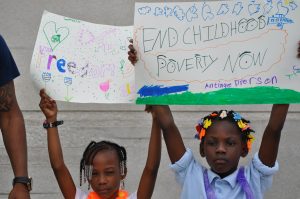
Poverty is defined as “a state or condition in which a person or community lacks the financial resources and essentials for a minimum standard of living”(Investopedia). This means that the person or community can not afford to fulfill the basic human needs such as shelter and food. In the United States, the current poverty rate in 11.8% and that number estimates to around 38.1 million Americans are in poverty(Census Bureau). Out of those 38.1 people, 15 million are children who are living with their families(NCCP). The United States is a more developed country, it has the highest rate of child poverty in the world. About 30% of children who grow up in poverty do not finish high school and in today’s workforce, employers look for candidates who have a high school diploma or higher education. Poverty places children and students of all ages at a large disadvantage and allows a cycle of poverty to continue in some cases.

https://www.childrensdefense.org/policy/policy-priorities/child-poverty/
Poverty in America is not the only issue. Around the world, there are at least 1 billion children in poverty and every day, it is estimated that 22,000 children die due to poverty (UNICEF). According to the World Bank, nearly half the world Lives on less than $5.50 a day despite continual decline in extreme poverty. Despite not having enough food, people in poverty do not have access to clean drinking water, proper shelter, or necessary clothing. The consequences of poverty are very real and often close to us. It is in this perspective that we look into the effects of poverty on educational opportunities. As part our project, we explored different aspects of the impact of poverty on educational opportunities in an attempt to propose some solutions to this endemic issue.